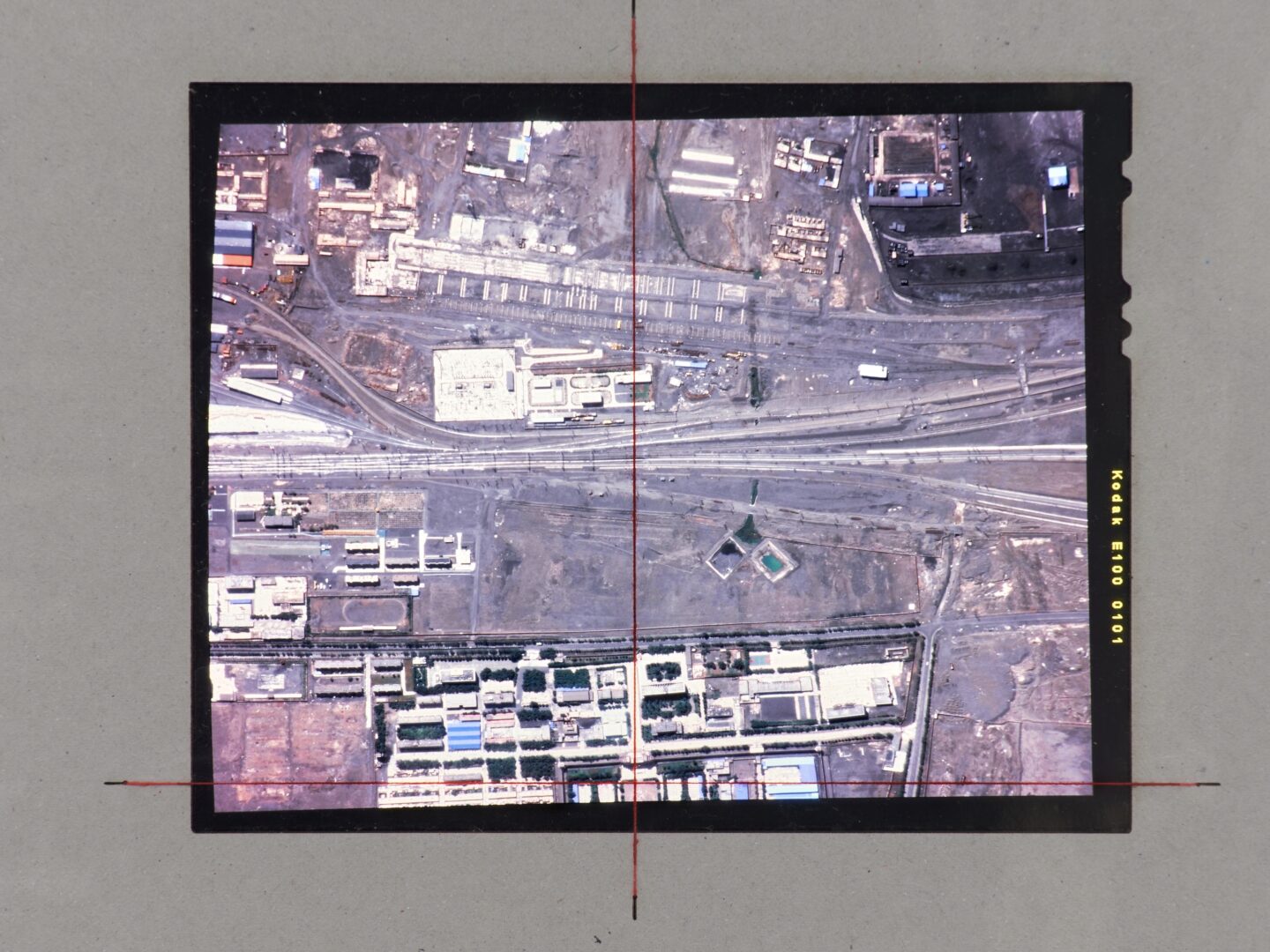The multi-part work Westbound-190621 is a continuation of the examination of the (meta-)physical infrastructure of the “One Belt, One Road” initiative and builds upon the ‘Break of Gauge’ installation, originally shown at the Kunstverein Harburger Bahnhof. The core of both works is a single, continuous and seamless aerial photograph of the freight train connection between China (Zhengzhou) and Germany (Hamburg). The picture of the 9,840-kilometre route — exposed on a total of 320 metres of 35 mm film — was created using an interplay of analogue and digital processes. It describes the course of a delivery of goods on June 21, 2019. The entire film Westbound-190621 is projected onto five large, backlit wall panels. As you approach, you can see that the depth of detail is only limited by your own eyesight and not the actual image information. When viewed from a distance, the imagery again blurs into abstract patterns. Switching between the micro and macro levels enables a dimensional / to scale classification of the trade connection and its political, social and ecological implications.
This abstract connection between two points is a fictional, linear projection of a map. The alleged logic and objectivity are far more complex upon closer inspection, like the factual sobriety of the movement of goods. On the image level, based on the breaks in the course, it shows differences in quality and colour or the distortions and artefacts that arose during straightening — ultimately, a problem that maps of the world have always been subject to: each representation makes decisions about how they show what, at which place, and how centre and direction are determined. Cardinal points and coordinates are here used for orientation and are incorrectly perceived as being naturally set. In this work series, all of these have been cancelled and subjected to a simple linearity that knows neither north nor south, nor other systems of order.
The way this work series is presented is reminiscent of archiving an artefact, and elevates what is depicted to a temporal document. Originally designed for the exhibition ‘Steppes and Silk Roads’ at MARKK Hamburg, the work was shown as a juxtaposition with a scroll more than twelve metres long containing 25 hand-drawn maps of Chinese provinces, borderlands and tributary states from MARKK Hamburg’s collection dating back to the 18th century. The deliberate juxtaposition refers to the colonial world and trade order of different epochs, in which the museum is involved through its own history of development. What remains are questions about cartographic stringency and purpose, provenance, and the legacy of those historical contexts that inextricably link these (cultural) institutions to German colonialism and how this is being reappraised.
Since the work was produced, new information has been published that shows with unprecedented clarity the extent of the oppression of the Uyghurs in Xinjiang by Chinese authorities. Data published this spring by the East Turkistan Government in Exile also includes geo-locations of internment camps and prisons that — following a cold logic — have been established along the newly constructed infrastructure routes. A comparison with the used satellite data from 2019 revealed that, even despite the narrow field of view, some of these facilities are depicted on the displayed film material. The new knowledge about the content of the images retrospectively alters the statement of the work, which no longer allows a presentation in the original form for me.
Paul Kolling lives in Berlin and makes works about infrastructural and economic processes and their integration into environmental and social structures. His research into and (re-)appropriation of emerging technologies is rearranged to reveal new perspectives that can be obscured through complexity and rhetoric. The outcomes are technological systems, installations and hybrid objects that strive to make complicated issues accessible.
Paul is one third of terra0.org, a research group exploring the creation of hybrid ecosystems in the technosphere. His (other) projects range from objects and installation works for exhibits and galleries, to publications, lectures and panel discussions. His projects have been presented and discussed at Ars Electronica, Biennale de Lyon, Drugo More, Furtherfield Gallery, Kunstverein Harburger Bahnhof, Schinkel Pavillon, transmediale and Vienna Biennale, amongst others.
Since 2020 he holds a teaching position as “Künstlerische Werkstattleitung Mechatronik” at the Berlin University of the Arts and is a participant in the BPA// Berlin program for artists 2021/22.
